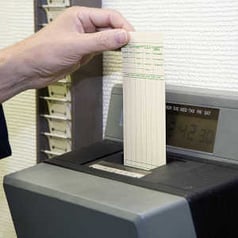As we approach the end of 2023 and set our sights ...
 Like most California labor laws, the state’s laws regarding meal and rest times are confusing to follow. Should you break them, you’ll be penalized with potentially significant fines. In fact, Wells Fargo has paid out $97.2 million to employees because of its violations.
Like most California labor laws, the state’s laws regarding meal and rest times are confusing to follow. Should you break them, you’ll be penalized with potentially significant fines. In fact, Wells Fargo has paid out $97.2 million to employees because of its violations.
To help you stay on the right side of the law, here are some things you need to know about documenting breaks and lunch hours.
The meal and rest break rules specify the amount of time employees must be given to rest and eat, if these breaks are paid, and how many hours an employee must work in a given day before they’re entitled to them.
Your employees must be given one ten-minute paid rest break for every four hours of work and one 30-minute unpaid meal break for every five hours of work.

If an employee works less than 4 hours but more than 3.5 hours, the law states that the employer should round up the hours worked to four.
Not all employees are covered under these laws. Some exempt employees include:
Any employees who do not fall into any of the above categories are entitled to their breaks.
Documenting breaks is meant to protect you as the employer. If an employee claims you denied them breaks and you have no documentation to verify that you, in fact, gave them their legally mandated time, you’ll be forced to pay them two hours of wages for every day you’re alleged to have denied them their time. Documenting reduces your liability should someone make a false accusation.

Sometimes, it isn’t possible for employees to take their break at the expected time. For example, a nurse might be assisting in an emergency surgery or a truck driver may be on the road and unable to stop at the right time.
The law does allow for exceptional cases such as these, assuming the employer and employee both agree to delay the break. The agreement must be in writing and state that the employee can cancel the agreement. Also, the employee must be paid for the time worked.
In cases like this, it’s best to consult with a labor lawyer to ensure you’re taking the best course of action based on how the law is written, otherwise, you’re leaving yourself open to lawsuits.
Knowing that breaks and lunch hours need to be documented is one thing. Putting this knowledge into practice is another. As an employer, you can’t directly supervise employees at all times. However, there are things you can do to increase the accuracy of your time tracking.
Ultimately, most employees will be happy to take their breaks, so they’re likely to work with you on the process.
If an employee does file suit against you for denying them break time, your business insurance policy should be able to help you. Contact your company as soon as possible to speed up the process. Liability coverage gives you access to lawyers needed to fight your case. Keep in mind, though, that without the proper documentation, it might not be a case you can win, which is why documenting these breaks is critical.


At LCK Insurance Agency, we can connect you with the business insurance policy that best meets your needs. From covering you in a lawsuit to helping you recover losses from property damage, a business policy is central to your success.
If you’re interested in changing policies or lowering your premiums, speak with one of our knowledgeable agents today.
As we approach the end of 2023 and set our sights ...
Employee benefits will help your small business re...
Paid vacation time, health insurance, tuition reim...
Leap | Carpenter | Kemps Insurance Agency provides Commercial Business Insurance, Employee Benefits, Life and Health Insurance, and Personal Insurance to all of California, including Merced, Atwater, Los Banos, Mariposa, Madera, Fresno, Modesto, Turlock, and Stockton.
CA License Number 0646081 | Licensed to do business in California, Arizona, Hawaii, Idaho, Montana, Nevada, North Carolina, Oklahoma, Oregon, Virginia, West Virginia and Washington.
© Copyright 2023 Leap | Carpenter | Kemps Insurance Agency — Privacy Policy | Terms & Conditions.
Merced Office
3187 Collins Drive
Merced, CA 95348
Phone: (209) 384-0727
Additional Contacts
Toll Free: (800) 221-0864
Fax: (209) 384-0401